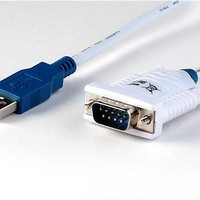UT232R-500-BULK FTDI, UT232R-500-BULK Datasheet - Page 21

UT232R-500-BULK
Manufacturer Part Number
UT232R-500-BULK
Description
Cables (Cable Assemblies) USB to RS232 Embeded Conv w/ThumbScrew 5m
Manufacturer
FTDI
Datasheet
1.UT232R-500-BULK.pdf
(24 pages)
Specifications of UT232R-500-BULK
Product
USB to Serial Assemblies
Number Of Conductors
9
Wire Size (awg)
24
Connector End A
USB Type A Plug
Connector End B
DB9 Male
Length
5 m
Cable Type
USB to RS-232 Serial Converter Cable
Description/function
USB to Serial Cable Assembly
Equipment Type
USB to Serial Cable Adapter
Color
White
Lead Free Status / RoHS Status
Lead free / RoHS Compliant
9
Cables are the most common sources of trouble with external devices.
Check the following:
-
-
-
-
-
RS232 cables – check the following:
-
-
-
-
Ensure the latest device driver is in use. See
If other devices with FTDI chips are installed in the system, check with all manufacturers of these devices
for the latest device drivers.
See the FTDI installation guides for additional details:
Common Windows Device Driver Troubles:
9.1
9.2
USB cable is properly inserted
Computer power is ON
Computer is not in Sleep or Standby
If a USB Hub is used, be sure it is set for “Self-Powered” operation
If a USB Hub is used, be sure all cables are properly inserted
Output signals (TXD, RTS, DTR) are connected to the respective inputs (RXD, CTS, DSR) in each
direction.
Check for specific handshake requirements of your RS232 peripheral.
If handshake signals are not used, ensure the application is set to “No Hardware Handshake”, or
equivalent.
Test the port with a loop-back connector. Connect TXD to RXD, RTS to CTS and DTR to DSR. Use a
simple terminal program (e.g. HyperTerminal) to check that data is transmitted and received.
Troubleshooting
DEVICE TIMES OUT: The default settings of the device driver assume typical data transfers of
hundred to thousands or more bytes at a given time. Some applications, such as a GPS device,
only send data in short packets, often only a few bytes. If this is the case, it may be necessary
to adjust the drivers buffer size and/or latency timer to smaller values. These values can be
adjusted through the Advanced driver options as noted in Figure 2.13. The buffer size can be
reduced to 64 bytes. The latency timer can be set as low as 2ms. A setting of 1ms will cause
unnecessary USB traffic and could adversely affect data transmission.
ERRATIC MOUSE POINTER: The device driver defaults to query an attached device to find out
whether it is a mouse or modem, consistent with native COM port operation. Some RS232
peripherals constantly send short packets of data, causing the host system to “think” a mouse or
modem has been attached. These short packets will interfere with normal mouse operation
causing the pointer to jump around the screen. If this happens, disconnect the RS232 device and
uncheck the Serial Enumerator option, also found on the Advanced driver options screen in Figure
2.13.
COM PORT IN USE: Windows keeps track of all COM port assignments. If multiple FTDI products
have been connected to a single system, the COM port number will increase, even if the other
devices are not attached. If the higher COM port assignments are not acceptable for the
application, known unused COM port numbers should be uninstalled according to the FTDI
installation guide: http://ftdichip.com/Documents/InstallGuides.htm.
Hardware
Device Driver
Copyright © 2010 Future Technology Devices International Limited
DS_UT232R-200(500)
www.ftdichip.com
http://ftdichip.com/Documents/InstallGuides.htm
USB TO RS232 ADAPTER CABLE Data
Document Reference No.: FT_000341
Clearance No.: 180
21
Version 1.0
Sheet




